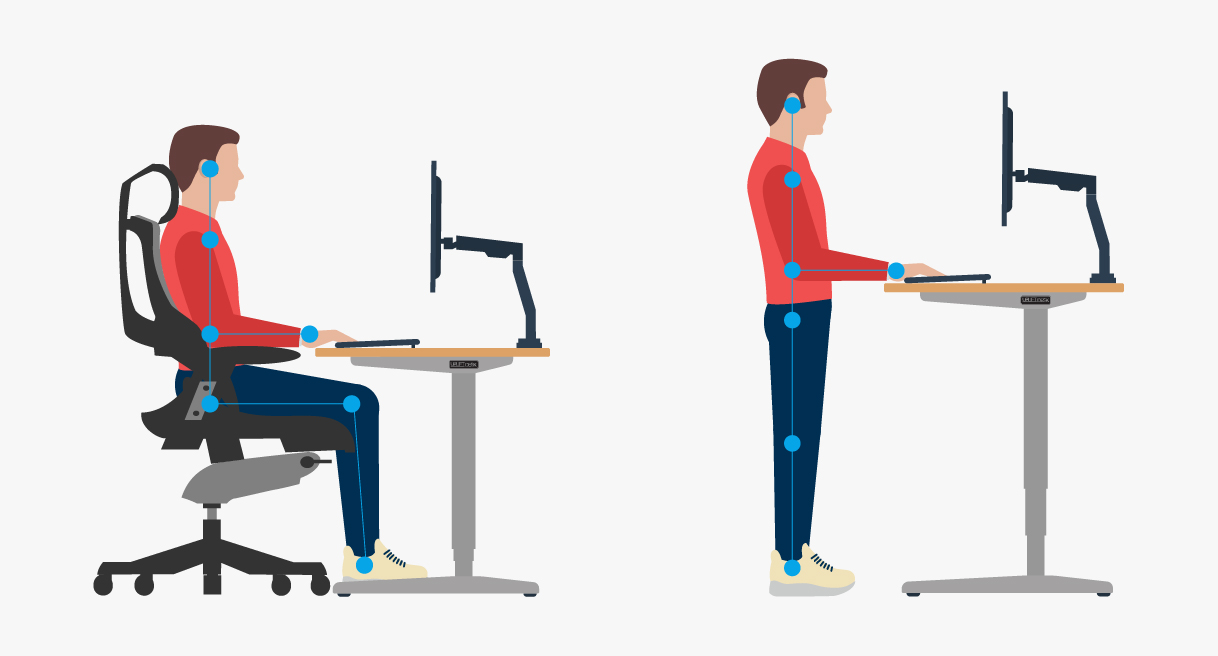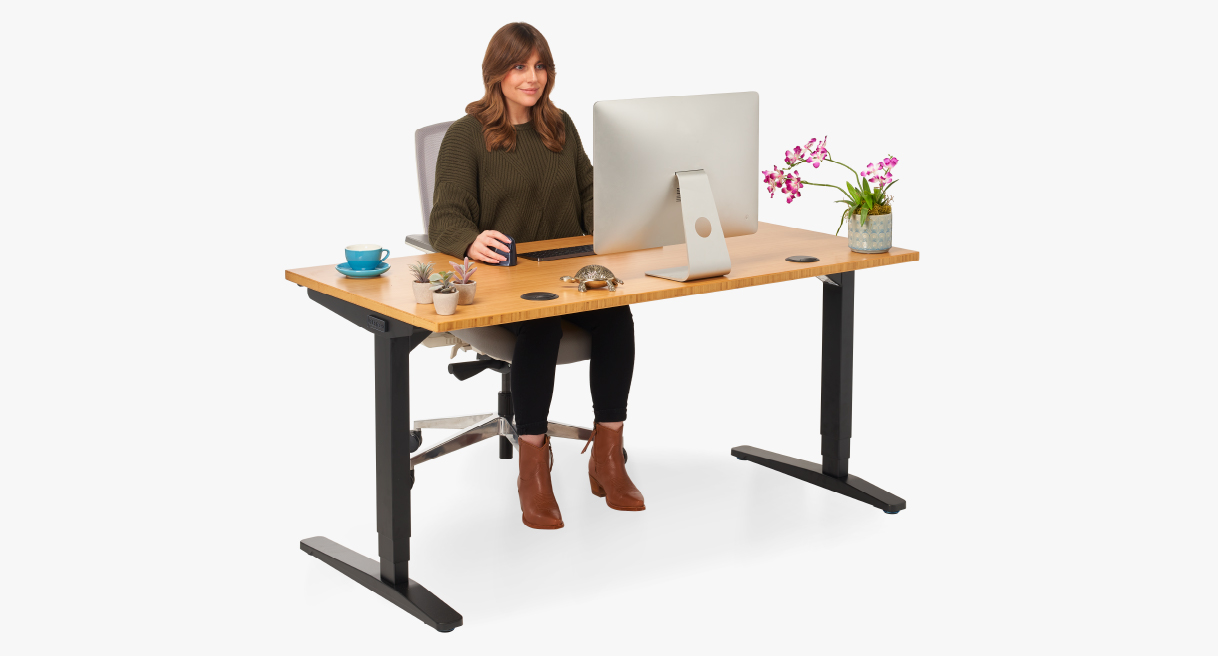
Reach your fitness goals with these four ergonomic tips
Feel better, stay healthier, work happier. Check out these tips for meeting fitness goals with the help of ergonomics.
Proper ergonomic practices can help you interact with your work environment better and be more efficient. Other benefits include improvements to your health, productivity, and fitness. With just a few simple changes to your workstation, you can achieve results and get closer to those fitness goals. Harness these four ergonomic tips to stay healthy in the long run!
1. Use a standing desk instead of sitting all day.
Using a standing desk is a great way to add more movement and activity to your workday, helping you move more and get more fit. Studies have shown that standing for at least three hours a day can reduce the risk of cardiovascular disease by up to 147%. People who use standing desks also tend to burn more calories than those who remain sedentary throughout the workday.
Research has also revealed that using a standing desk can help improve posture, reduce fatigue, and boost productivity. Employees can experience an improved mood and increased focus due to increased blood flow throughout the body. Standing desks are also beneficial for muscle engagement and coordination.
In addition to the physical benefits of using a standing desk, people who use standing desks find it easier to stay alert and engaged compared to if they had been seated all day long. All these advantages add up to healthier habits that can help contribute toward achieving one's overall fitness goals.

2. Take breaks every hour to move around and stretch.
It's well known that physical activity has a positive effect on overall health. Regular movement and stretching helps to improve circulation, reduce the risk of cardiovascular diseases, prevent joint stiffness and pain, increase strength and flexibility, and even boost mood and focus. In comparison, staying seated for extended periods of time can lead to poor posture and negative health outcomes such as obesity, diabetes, cardiovascular issues, and more. This is why it is so important to incorporate regular breaks into the work day.
Ergonomic office furniture can be a great way to support healthier habits at work. By using adjustable chairs with good lumbar support or a standing desk with an anti-fatigue mat underneath, you can encourage better posture during the day while boosting energy levels (bonus points for adding a motion board, treadmill, or bike to your height adjustable desk). A standing desk can also help prevent stiffness or muscle fatigue caused by sitting in one position for long hours.
Finally, taking breaks is essential if you want to reach your fitness goals while working from home or office. Just like any other exercise routine, it's important that these breaks are frequent enough to become part of your daily routine. Try to move around or stretch every hour or so to give yourself a break from sitting all day long. Taking short but frequent breaks throughout the day will not only help keep you energized but also help provide needed physical activity which then translates into better fitness outcomes over time.

3. Maintain proper posture.
The importance of ergonomics and posture with respect to recovering from exercise cannot be understated. Proper ergonomic office furniture, such as adjustable chairs with lumbar support, standing desks with anti-fatigue mats, and other items that promote proper posture are invaluable in helping to facilitate recovery. Ergonomic postures help decrease muscular fatigue, reduce the risk of injury due to overuse or incorrect muscle activation, and improve the circulation of blood throughout the body, aiding in muscle recovery.
Statistics show that those who maintain ergonomic postures during their daily activities have a significantly better chance at recovering successfully from a workout. According to one study by the University of Rochester Medical Center, 77% of people who took part in an ergonomic intervention program reported improved comfort levels and 62% felt that their musculoskeletal pain was reduced following their participation in the program. Furthermore, another study conducted at Stanford University found that improved seated postures helped reduce perceived discomfort levels by up to 83%.
Aside from these statistics, maintaining good posture is essential for avoiding injuries and strains caused by incorrect muscle activation during exercise. Poor posture can cause muscles to become overworked or strained more easily due to an imbalance between muscle groups on either side of a joint. This can lead to significant discomfort or even more serious problems such as ligament tears or chronic pain issues if not addressed quickly. Proper posture before, during, and after exercise helps prevent these types of injuries while also allowing one's body to perform more efficiently and effectively.

4. Let the body rest.
Sitting is an important part of achieving fitness goals, as it helps give the body time to rest and heal from physical activity and standing. It can also be beneficial for overall well being, as sitting in an ergonomic office chair supports the lumbar region of the back. By taking regular breaks throughout the day to sit in a supportive chair, you can allow muscles and joints to rest while still being productive.
One study conducted at the University of Texas found that those who take regular breaks during the day to rest in an ergonomic office chair experience fewer episodes of musculoskeletal pain than those who stand all day. But definitely do not sit all day, either! This study found that participants who took regular breaks throughout the day had significantly lower rates of foot, back, and neck pain than those who did not. Furthermore, these participants also reported less fatigue and better concentration levels compared to their counterparts.
An ergonomic office chair provides more than just comfort; it also helps support the back and neck by providing lumbar support while helping maintain proper posture. Poor posture can lead to a number of problems such as muscular fatigue or strain, which can result in injury or chronic pain if not addressed quickly. Properly supporting the back and neck with an ergonomic office chair helps reduce these risks by allowing the body to rest in a way that promotes proper back and arm posture.
When sitting in an ergonomic office chair, it is essential to make sure your feet are flat on the floor or that you're using a footrest for support. A supportive backrest will ensure that your lower back is properly curved and supported to prevent slouching. In addition, having your feet flat on the floor reduces the risk of developing issues associated with too much seat pressure on the back of the knees on the sciatic nerve.
Reach fitness goals with ergonomics.
Using ergonomic standing desks and chairs is a great way to reach health and fitness goals while still doing productive work. If you're looking for an effective way to stay healthy and productive at the same time, investing in ergonomic furniture is certainly worth considering! So why not take action today and make your workspace more conducive to achieving your health and fitness goals?